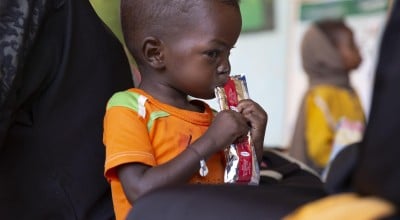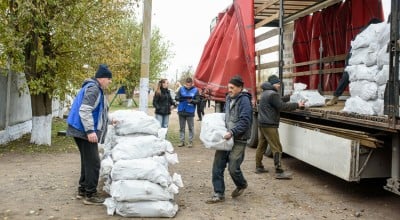
Read our 2024 annual report

Knowledge Hub
This week, world leaders gathered in Jerusalem to mark 75 years since Soviet troops liberated Auschwitz, the notorious extermination camp that had become the epicentre of the Holocaust.
Earlier this week a smaller but similar gathering took place on the Thai Cambodian border. Over 140 Cambodian, Thai and foreign aid workers met to mark the establishment of the massive humanitarian operation that was mounted to assist hundreds of thousands of Cambodians.
In 1979, the Vietnamese invasion of Cambodia brought an end to the genocidal Khmer Rouge regime that, over four years, had led to the brutal and systematic death of over a million people.
The world watched with horror as survivors of the genocide, starving, sick and terrified, spilled across the border into Thailand, triggering a massive international response to what was then the largest humanitarian crisis of its time.
Within four days UNHCR established a temporary refugee camp at the base of the Kho-I-Dang Mountain 45 kilometres from the Thai border town of Aranyaprathet.
Designed to accommodate 30,000 people, within two months the numbers had swollen to over 84,000. By the time I arrived in 1982 to work with Concern, Khao-I-Dang was home to 160,000 people and was said to be the largest concentration of Cambodians outside Cambodia.
Concern worked across every section of camp but our largest operations were in the unofficial border camps where teams of nurses and engineers ran the maternal child health clinics and sanitation services for hundreds of thousands of refugees.
Situated in what was an active war zone, these camps were frequently attacked. Everyone remembers Christmas Day 1984 when Nong Samet, one of the largest camps, was heavily shelled, forcing thousands to flee.
We worked with the UN and other agencies to relocate and rebuild these camps, not once but multiple times. Eventually 11 of the border camp were consolidated into a new camp, further away from the border and the shelling. Site 2, as it was called, became home to 198,000 refugees. A massive, sprawling, city of bamboo.
It was the largest refugee settlement in South East Asia.
While the camp offered sanctuary, lack of employment, overcrowding and shortages of food and water made life for the refugees under these precarious circumstances extremely difficult and had to be endured for many years.
It wasn’t until the signing of the 1991 Paris peace accords and the establishment of the UN Transitional Authority in Cambodia that the prospect for a peaceful return was possible.
Khao-I-Dang was the first camp to close. For 13 years it had been a desperately overcrowded sanctuary and a critical gateway for resettlement to a third country. At the closing ceremony in March 1993, the UN Special representative Sergio de Mello called Khao-I-Dang a powerful and tragic symbol of the Cambodian exodus and the international humanitarian response.
A few months later the thousands of refugees from Site 2 were bussed back home. I remember being on the first convoy of buses to cross back over the border.
The sense of excitement and fear on people’s faces was clearly evident as they returned home to an uncertain future. Over 360,000 refugees were repatriated. We would stay on in Cambodia for another decade to help the country to rebuild and recover.
Among the 140 people who gathered at the border last week, the largest group were the Cambodians themselves, many of them has been on those buses and had slowly rebuilt their lives over the following years. For them, the weekend was much more than remembrance, it was a statement of survival against horrific odds, of shattered lives rebuilt
Banrouneg, one of the group. vividly remembered how as a young teenager he had tried to escape the Khmer Rouge twice before finally succeeding the third time. Setting out with a group of six others, he was the only one to survive the journey to Thailand. The rest had died from either sickness or from stepping on land mines. Despite the harsh life he endured in the camps, Banrouneg was eternally grateful to the Thai authorities for the refuge and sanctuary that had been offered.
When images of Auschwitz emerged, the world saw human suffering at an almost incomprehensible level and said never again. And yet just over 20 years later, the seeds of the Cambodian tragedy were being sown.
As far back as March 1969, Nixon and Kissinger began secretly bombing Vietnamese bases inside Cambodia. The tonnage of bombs dropped was equal to all the bombs they dropped in World War 2 and led to the destabilisation of any already vulnerable country that ultimately contributed to the rise of the Khmer Rouge.
The shocking images of the survivors of the Cambodian genocide horrified public opinion, evoking once again images of the Nazi genocide.
Fuelled by a sense of compassion, guilt and responsibility the world responded with generosity. More than 260,000 refugees were resettled, the majority to the US but also Canada, Australia and France.
While the Vietnam War ended in 1972, its impact fuelled by super power involvement cast a long shadow on neighbouring Cambodia and led to human suffering at an almost incomprehensible level.
Now, the situation for many Syrians and Rohingya refugees is disturbingly comparable but the international response is not.
The same spirit of international solidarity and shared responsibility that was extended to the Cambodian refugees has become the burden of neighbouring countries.
Remembrance is important but should be much more than a tribute to the past and its foremost importance is to remind us to act in the present.





